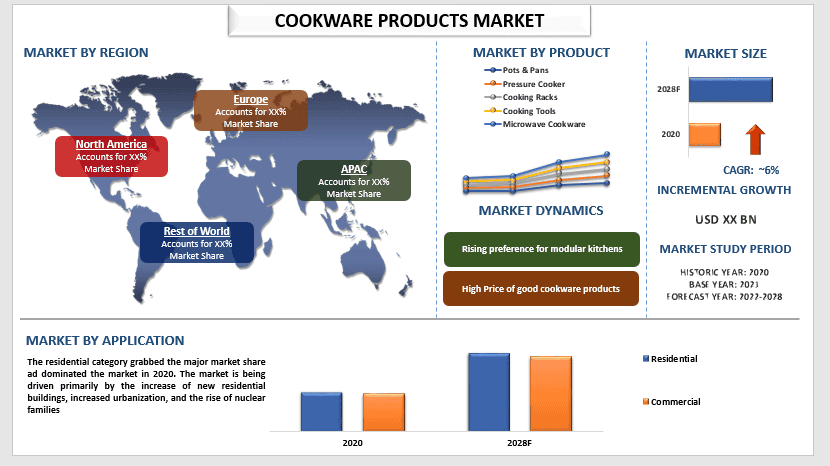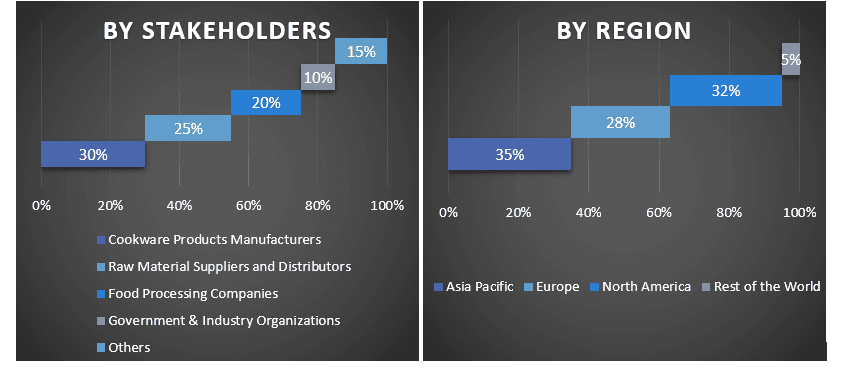- Inicio
- Acerca de nosotros
- Industria
- Servicios
- Leyendo
- Contáctenos
Mercado de productos de utensilios de cocina: análisis actual y previsión (2022-2028)
Producto (Ollas y Sartenes, Olla a Presión, Rejillas de Cocción, Utensilios de Cocina, Utensilios para Microondas); Material (Acero Inoxidable, Aluminio, Vidrio, Otros); Aplicación (Residencial, Comercial); Canal de Distribución (Online, Offline); Región/País

Se espera que el Mercado Global de Productos de Utensilios de Cocina crezca a una tasa significativa de alrededor del 6% durante el período de pronóstico. Debido a la creciente preferencia del consumidor por las cocinas modulares, el aumento del gasto en remodelación del hogar o proyectos de mejora también está impulsando la demanda de productos. El gasto en renovación de viviendas ha aumentado a una tasa anual del 6% en los últimos tres años a partir de 2015, según el Índice Líder de actividades de remodelación. Además, los fabricantes están colaborando con constructores y contratistas para proporcionar a la cocina los suministros de utensilios de cocina adecuados.
La popularidad de las comidas preparadas en casa ha sido influenciada en gran medida por los millennials, y esto a su vez ha aumentado la demanda de artículos de utensilios de cocina. Algunas de las tendencias que están remodelando la industria de utensilios de cocina residenciales incluyen más color, piezas flexibles para espacios más pequeños y artículos que satisfacen las necesidades específicas de los consumidores. Además, el mercado se está expandiendo debido al aumento de cocinas comerciales, cafés y restaurantes. La necesidad de utensilios de cocina está siendo impulsada por la rápida construcción del sector comercial, particularmente en la industria de la hospitalidad. Para los clientes y restaurantes, comer fuera ahora implica algo más que simplemente comer. En la industria hotelera, la retención de clientes va más allá de la comida y se basa en lo bien que fue la experiencia general de los clientes.
Groupe SEB, Werhahn Group, Gorenje Group, Meyer Corporation, Fissler GmbH, Tramontina USA Icnc., Newell Brands Inc., TTK Prestige Ltd., The Vollarath Co. y Hawkins Cookers Limited, etc., son algunos de los actores clave en el mercado. Estos actores han emprendido varias fusiones y adquisiciones junto con asociaciones para facilitar a los clientes productos/tecnologías innovadoras y de alta tecnología.
Perspectivas presentadas en el informe
"Entre los productos, la categoría de ollas y sartenes será testigo de una CAGR más alta durante el período de pronóstico"
Según el producto, el mercado se segmenta en ollas y sartenes, ollas a presión, rejillas para cocinar, utensilios de cocina y utensilios de cocina para microondas. El segmento de ollas y sartenes se apoderó de la mayor cuota de mercado y dominó el mercado en 2020. Se prevé que el segmento se expanda constantemente a lo largo del período proyectado debido a la demanda de sartenes coloridas y multifuncionales. Sin embargo, los utensilios de cocina serán testigos de un crecimiento considerable durante los próximos años. El crecimiento de la demanda de estos productos se atribuye al crecimiento constante en el requisito de cucharas utilizadas para cocinar y servir.
"Entre los materiales, el acero inoxidable mantendrá una participación significativa en el mercado en 2020"
Según el material, el mercado se clasifica en acero inoxidable, aluminio, vidrio y otros. Entre estos, el segmento de acero inoxidable se apoderó de la mayor cuota de mercado y dominó el mercado en 2020. Después del cobre, el aluminio es el mejor conductor de calor. En la mayoría de los casos, el aluminio natural se combina con alimentos ácidos para darle un sabor metálico y un color gris opaco. Numerosos productores venden utensilios de cocina de aluminio que han sido anodizados, recubiertos con acero inoxidable o revestidos con un revestimiento antiadherente para abordar este inconveniente.
"Entre las aplicaciones, la categoría residencial será testigo de una CAGR más alta durante el período de pronóstico"
Según la aplicación, el mercado se segmenta en residencial y comercial. La categoría residencial se apoderó de la mayor cuota de mercado y dominó el mercado en 2020. El mercado está siendo impulsado principalmente por el aumento de nuevos edificios residenciales, el aumento de la urbanización y el aumento de las familias nucleares. Por lo tanto, se prevé que en los próximos años, estos cambios en la categoría de hogares residenciales impulsen la necesidad de utensilios de cocina.
"Entre los canales de distribución, el offline mantendrá una participación significativa en el mercado en 2020"
Según el canal de distribución, el mercado se clasifica en online y offline. Entre estos, el segmento offline se apoderó de la mayor cuota de mercado y dominó el mercado en 2020. La flexibilidad de elección, los menores costos y la mayor visibilidad de las marcas globales son solo algunos de los considerables beneficios que los consumidores pueden disfrutar del canal de distribución offline.
"Asia Pacífico mantendrá una participación significativa en el mercado"
En 2020, Asia Pacífico mantuvo una participación significativa en el mercado mundial de productos de utensilios de cocina. Un aumento en los cafés, hoteles y restaurantes en toda la región está llevando a la creciente demanda del mercado de productos de utensilios de cocina. Además, el crecimiento de la industria de viajes y turismo y el creciente atractivo de los restaurantes de servicio rápido (QSR) entre los millennials también están contribuyendo a la creciente demanda de productos de utensilios de cocina. Según Statista, el número de establecimientos de servicio de alimentos en todo el mundo varió mucho según la región en 2020. Asia-Pacífico tenía la mayor cantidad de establecimientos con más de 17 millones. En comparación, la región con el segundo número más alto de establecimientos de servicio de alimentos fue América Latina con más de 2.3 millones.
Razones para comprar este informe:
- El estudio incluye el tamaño del mercado y el análisis de pronóstico validados por expertos clave de la industria autenticados.
- El informe presenta una revisión rápida del desempeño general de la industria de un vistazo.
- El informe cubre un análisis en profundidad de los principales pares de la industria con un enfoque principal en las finanzas clave del negocio, la cartera de productos, las estrategias de expansión y los desarrollos recientes.
- Examen detallado de los impulsores, las restricciones, las tendencias clave y las oportunidades que prevalecen en la industria.
- El estudio cubre de manera integral el mercado en diferentes segmentos.
- Análisis profundo a nivel regional de la industria.
Opciones de personalización:
El mercado global de productos de utensilios de cocina se puede personalizar aún más según los requisitos o cualquier otro segmento de mercado. Además de esto, UMI entiende que puede tener sus propias necesidades comerciales, por lo tanto, no dude en conectarse con nosotros para obtener un informe que se adapte completamente a sus requisitos.
Tabla de contenido
Metodología de Investigación para el Análisis del Mercado de Productos de Cocina (2022-2028)
El análisis del mercado histórico, la estimación del mercado actual y la previsión del mercado futuro del mercado mundial de productos de cocina fueron los tres pasos principales que se llevaron a cabo para crear y analizar la adopción de productos de cocina en las principales regiones del mundo. Se llevó a cabo una exhaustiva investigación secundaria para recopilar las cifras históricas del mercado y estimar el tamaño actual del mercado. En segundo lugar, para validar estos conocimientos, se tuvieron en cuenta numerosos hallazgos y supuestos. Además, también se realizaron exhaustivas entrevistas primarias con expertos de la industria a lo largo de la cadena de valor del mercado mundial de productos de cocina. Tras la suposición y validación de las cifras del mercado a través de entrevistas primarias, empleamos un enfoque de arriba hacia abajo/de abajo hacia arriba para pronosticar el tamaño completo del mercado. Posteriormente, se adoptaron métodos de desglose del mercado y triangulación de datos para estimar y analizar el tamaño del mercado de los segmentos y subsegmentos de la industria a la que pertenece. La metodología detallada se explica a continuación:
Análisis del Tamaño Histórico del Mercado
Paso 1: Estudio Detallado de Fuentes Secundarias:
Se llevó a cabo un estudio secundario detallado para obtener el tamaño histórico del mercado de productos de cocina a través de fuentes internas de la empresa, como informes anuales y estados financieros, presentaciones de resultados, comunicados de prensa, etc., y fuentes externas, incluyendo revistas, noticias y artículos, publicaciones gubernamentales, publicaciones de la competencia, informes sectoriales, bases de datos de terceros y otras publicaciones creíbles.
Paso 2: Segmentación del Mercado:
Después de obtener el tamaño histórico del mercado de productos de cocina, llevamos a cabo un análisis secundario detallado para recopilar información histórica del mercado y compartirla para diferentes segmentos y subsegmentos para las principales regiones. Los principales segmentos incluidos en el informe son el producto, el material, la aplicación y el canal de distribución. Además, se realizaron análisis a nivel de país para evaluar la adopción general de modelos de prueba en esa región.
Paso 3: Análisis de Factores:
Después de adquirir el tamaño histórico del mercado de diferentes segmentos y subsegmentos, llevamos a cabo un análisis de factores detallado para estimar el tamaño actual del mercado de productos de cocina. Además, realizamos un análisis de factores utilizando variables dependientes e independientes como el producto, el material, la aplicación y el canal de distribución de los productos de cocina. Se llevó a cabo un análisis exhaustivo de los escenarios de oferta y demanda teniendo en cuenta las principales asociaciones, fusiones y adquisiciones, la expansión empresarial y los lanzamientos de productos en el mercado de productos de cocina en todo el mundo.
Estimación y Previsión del Tamaño Actual del Mercado
Tamaño Actual del Mercado: Basándonos en los conocimientos prácticos de los 3 pasos anteriores, llegamos al tamaño actual del mercado, a los principales actores del mercado mundial de productos de cocina y a las cuotas de mercado de los segmentos. Todos los porcentajes de participación, las divisiones y los desgloses del mercado necesarios se determinaron utilizando el enfoque secundario mencionado anteriormente y se verificaron a través de entrevistas primarias.
Estimación y Previsión: Para la estimación y previsión del mercado, se asignaron ponderaciones a diferentes factores, incluyendo los impulsores y las tendencias, las restricciones y las oportunidades disponibles para las partes interesadas. Después de analizar estos factores, se aplicaron las técnicas de previsión pertinentes, es decir, el enfoque de arriba hacia abajo/de abajo hacia arriba, para llegar a la previsión del mercado para 2028 para diferentes segmentos y subsegmentos en los principales mercados a nivel mundial. La metodología de investigación adoptada para estimar el tamaño del mercado abarca:
- El tamaño del mercado de la industria, en términos de ingresos (USD) y la tasa de adopción del mercado de productos de cocina en los principales mercados nacionales
- Todas las cuotas porcentuales, las divisiones y los desgloses de los segmentos y subsegmentos del mercado
- Los principales actores del mercado mundial de productos de cocina en términos de productos ofrecidos. Además, las estrategias de crecimiento adoptadas por estos actores para competir en el mercado de rápido crecimiento
Validación del Tamaño y la Cuota de Mercado
Investigación Primaria: Se realizaron entrevistas en profundidad con los Líderes de Opinión Clave (KOL) incluyendo a los Ejecutivos de Alto Nivel (CXO/VPs, Jefe de Ventas, Jefe de Marketing, Jefe de Operaciones, Jefe Regional, Jefe de País, etc.) en las principales regiones. Los hallazgos de la investigación primaria fueron resumidos, y se realizó un análisis estadístico para probar la hipótesis establecida. Los aportes de la investigación primaria se consolidaron con los hallazgos secundarios, convirtiendo así la información en conocimientos prácticos.
División de los Participantes Primarios en Diferentes Regiones

Ingeniería de Mercado
Se empleó la técnica de triangulación de datos para completar la estimación general del mercado y para llegar a números estadísticos precisos para cada segmento y subsegmento del mercado mundial de productos de cocina. Los datos se dividieron en varios segmentos y subsegmentos después de estudiar varios parámetros y tendencias en el producto, el material, la aplicación y el canal de distribución en el mercado mundial de productos de cocina.
El objetivo principal del Estudio del Mercado Mundial de Productos de Cocina
Las tendencias actuales y futuras del mercado mundial de productos de cocina se señalaron en el estudio. Los inversores pueden obtener conocimientos estratégicos para basar su criterio de inversión en el análisis cualitativo y cuantitativo realizado en el estudio. Las tendencias actuales y futuras del mercado determinaron el atractivo general del mercado a nivel regional, proporcionando una plataforma para que el participante industrial explote el mercado sin explotar para beneficiarse de una ventaja de ser el primero en actuar. Otros objetivos cuantitativos de los estudios incluyen:
- Analizar el tamaño actual y previsto del mercado de productos de cocina en términos de valor (USD). Además, analizar el tamaño actual y previsto del mercado de diferentes segmentos y subsegmentos
- Los segmentos del estudio incluyen las áreas de producto, material, aplicación y canal de distribución
- Definir y analizar el marco regulatorio para los productos de cocina
- Analizar la cadena de valor involucrada con la presencia de varios intermediarios, junto con el análisis de los comportamientos de los clientes y la competencia de la industria.
- Analizar el tamaño actual y previsto del mercado de productos de cocina para la principal región.
- Los principales países de las regiones estudiadas en el informe incluyen Asia Pacífico, Europa, Norteamérica y el resto del mundo.
- Perfiles de las empresas del mercado de productos de cocina y las estrategias de crecimiento adoptadas por los actores del mercado para mantenerse en el mercado de rápido crecimiento
- Análisis profundo a nivel regional de la industria
Relacionados Informes
Los clientes que compraron este artículo también compraron










